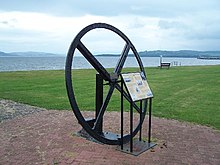Comet (ship, 1811)
|
A replica of the Comet in the center of Port Glasgow .
|
||||||||||||||
|
||||||||||||||
|
||||||||||||||
|
||||||||||||||
|
||||||||||||||
The Comet was the first European steamship to be used for commercial purposes.
history
Henry Bell was interested in steam-powered ships and therefore corresponded with Robert Fulton . Inspired by his ship Charlotte Dundas , he commissioned John and Charles Wood to build a ship in Port Glasgow in the winter of 1811. The boiler came from the workshop of David Napier and the single-cylinder steam engine from John Robertson. The steam engine powered two pairs of paddle wheels, which were later replaced by a pair of paddle wheels. A yard was attached to the very thin chimney, which was roughly in the middle of the ship , so that under suitable conditions one could also sail. In the back of the ship was a small cabin with wooden chairs and a table. Since the great comet Flaugergues was visible for several months in 1811 , Bell decided to name the ship Comet .
Henry Bell owned a hotel and baths in Helensburgh and from July 1812 set up regular traffic between Port Glasgow and Helensburgh with the steamboat . The first trip on this route was made in January 1812. The successful commercial use of the ship meant that steam shipping quickly established itself in Europe.
Shipwreck

Since the ship had meanwhile had superior competition, he had it converted and equipped with a more powerful steam engine. The new route of the parcel ship led from Port Glasgow to Fort William . The one-way trip took the ship two days; it reached Ardrishaig at the entrance to the Crinan Canal on the evening of the first day , then continued through the canal and reached its destination on the evening of the second day.
On December 15, 1820, the Comet hit a rock in a strong current near Crinan and sank, but there were no fatalities. The steam engine was salvaged and restored by Robert Napier & Sons and is now in the Science Museum in London .
Web links
Footnotes
- ^ Second Report of the Select Committee on the Roads from London to Holyhead and from Chester to Holyhead; Steam Packets. , 1822, p. 224 ( online )
- ^ The Steam Boat Companion; and Stranger's Guide to the Western Islands and Highlands of Scotland , Glasgow 1820, page VI ( online )
- ^ Edgar C. Smith , A Short History of Naval and Marine Engineering , 1937, pp. 15-16 ( online )
- ^ The Penny Cyclopaedia of the Society for the Difussion of Useful Knowledge , Volume 22, London 1842, p. 498 ( online )
- ^ The Steam Boat Companion; and Stranger's Guide to the Western Islands and Highlands of Scotland , Glasgow 1820, page 22 ( online )
- ^ Edgar C. Smith , A Short History of Naval and Marine Engineering , 1937, p. 16 ( online )
